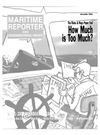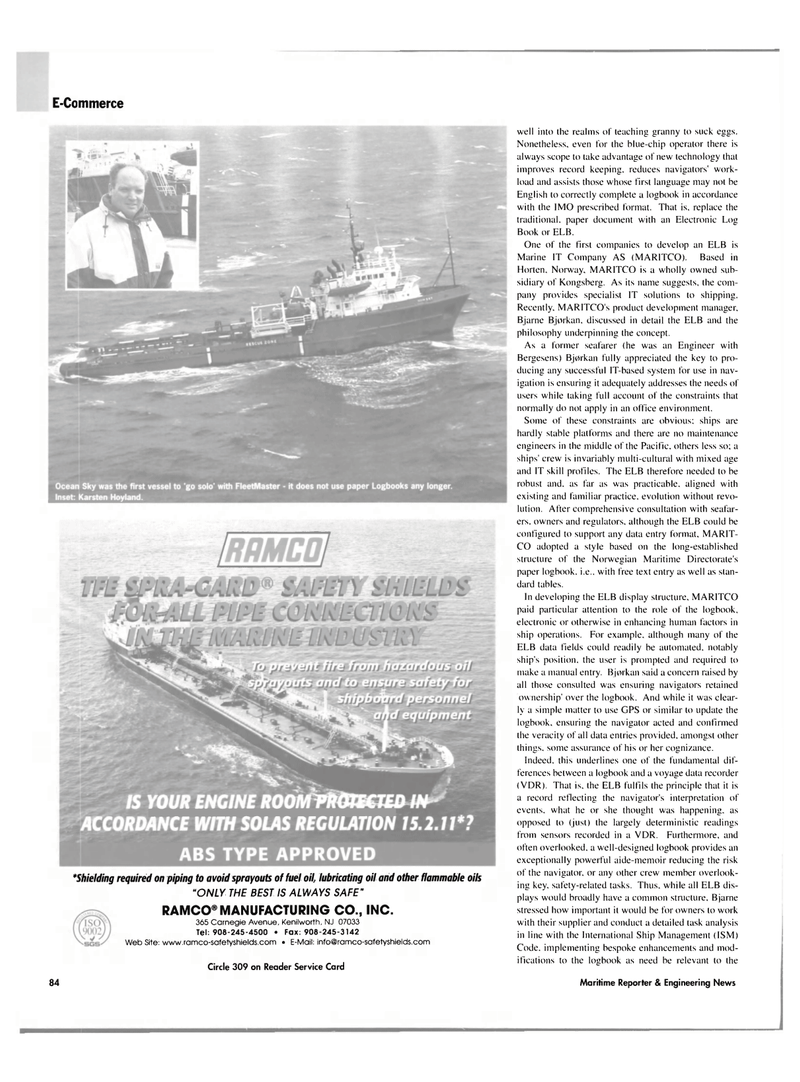
Page 87: of Maritime Reporter Magazine (November 2003)
Read this page in Pdf, Flash or Html5 edition of November 2003 Maritime Reporter Magazine
E-Commerce *Shielding required on piping to avoid sprayouts of fuel oil, lubricating oil and other flammable oils "ONLY THE BEST IS ALWAYS SAFE"
RAMCO® MANUFACTURING CO., INC. 365 Carnegie Avenue, Kenilworth, NJ 07033
Tel: 908-245-4500 • Fax: 908-245-3142
Web Site: www.ramco-safetyshields.com • E-Mail: [email protected]
Circle 309 on Reader Service Card well into the realms of teaching granny to suck eggs.
Nonetheless, even for the blue-chip operator there is always scope to take advantage of new technology that improves record keeping, reduces navigators' work- load and assists those whose first language may not be
English to correctly complete a logbook in accordance with the IMO prescribed format. That is. replace the traditional, paper document with an Electronic Log
Book or ELB.
One of the first companies to develop an ELB is
Marine IT Company AS (MARITCO). Based in
Horten, Norway. MARITCO is a wholly owned sub- sidiary of Kongsberg. As its name suggests, the com- pany provides specialist IT solutions to shipping.
Recently. MARITCO's product development manager,
Bjarne Bjorkan. discussed in detail the ELB and the philosophy underpinning the concept.
As a former seafarer (he was an Engineer with
Bergesens) Bj0rkan fully appreciated the key to pro- ducing any successful IT-based system for use in nav- igation is ensuring it adequately addresses the needs of users while taking full account of the constraints that normally do not apply in an office environment.
Some of these constraints are obvious; ships are hardly stable platforms and there are no maintenance engineers in the middle of the Pacific, others less so; a ships' crew is invariably multi-cultural with mixed age and IT skill profiles. The ELB therefore needed to be robust and, as far as was practicable, aligned with existing and familiar practice, evolution without revo- lution. After comprehensive consultation with seafar- ers. owners and regulators, although the ELB could be configured to support any data entry format, MARIT-
CO adopted a style based on the long-established structure of the Norwegian Maritime Directorate's paper logbook, i.e.. with free text entry as well as stan- dard tables.
In developing the ELB display structure, MARITCO paid particular attention to the role of the logbook, electronic or otherwise in enhancing human factors in ship operations. For example, although many of the
ELB data fields could readily be automated, notably ship's position, the user is prompted and required to make a manual entry. B j0rkan said a concern raised by all those consulted was ensuring navigators retained ownership' over the logbook. And while it was clear- ly a simple matter to use GPS or similar to update the logbook, ensuring the navigator acted and confirmed the veracity of all data entries provided, amongst other things, some assurance of his or her cognizance.
Indeed, this underlines one of the fundamental dif- ferences between a logbook and a voyage data recorder (VDR). That is, the ELB fulfils the principle that it is a record reflecting the navigator's interpretation of events, what he or she thought was happening, as opposed to (just) the largely deterministic readings from sensors recorded in a VDR. Furthermore, and often overlooked, a well-designed logbook provides an exceptionally powerful aide-memoir reducing the risk of the navigator, or any other crew member overlook- ing key. safety-related tasks. Thus, while all ELB dis- plays would broadly have a common structure, Bjarne stressed how important it would be for owners to work with their supplier and conduct a detailed task analysis in line with the International Ship Management (ISM)
Code, implementing bespoke enhancements and mod- ifications to the logbook as need be relevant to the 84 Maritime Reporter & Engineering News

 86
86

 88
88
